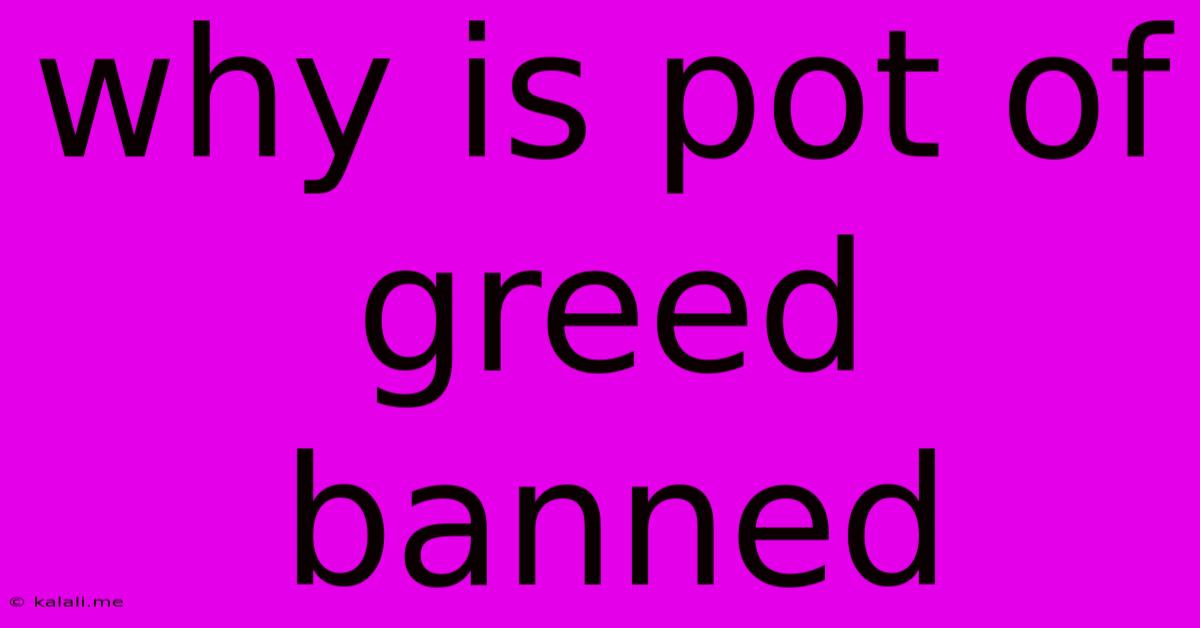Why Is Pot Of Greed Banned
Kalali
May 29, 2025 · 3 min read

Table of Contents
Why is Pot of Greed Banned? A Deep Dive into Yu-Gi-Oh!'s Most Notorious Card
Pot of Greed. The name alone evokes strong reactions within the Yu-Gi-Oh! community. This seemingly innocuous card, allowing you to draw two cards, has a history steeped in controversy, ultimately leading to its banishment from most competitive play formats. But why? This article delves into the reasons behind Pot of Greed's infamous ban, exploring its impact on the game's balance and its lasting legacy.
The Simple Power of Drawing Cards
At its core, Pot of Greed's power lies in its simplicity. Drawing two extra cards significantly boosts a player's hand advantage. In a game reliant on resource management and strategic card play, this advantage can be game-changing. This seemingly small boost allowed players to find key cards, set up powerful plays, and disrupt their opponent's strategies much more effectively. The consistent access to additional cards made it a powerful engine for many archetypes.
Breaking the Game's Balance: A Cascade Effect
The problem wasn't just the extra cards themselves; it was the consistent access to them. Unlike other cards with similar effects, Pot of Greed had no cost. This meant it could be played early and often, building a massive advantage without any penalty. This skewed the game's balance dramatically. Players could consistently find the cards they needed, leaving opponents struggling to catch up. It allowed for a faster pace of play that didn't necessarily reward strategic thinking, but rather, consistent card advantage.
The Dominance of Certain Archetypes
Pot of Greed's inclusion heavily favoured certain decks and strategies. Archetypes that relied heavily on card draw or powerful, yet inconsistent, effects became incredibly powerful when combined with Pot of Greed. This created a meta-game dominated by a handful of very specific decks, making the overall gameplay less diverse and more predictable. The lack of counterplay against such an effective and easily accessible card made it frustrating for many players.
The Legacy of Pot of Greed: A Lesson in Game Design
The ban of Pot of Greed serves as a crucial lesson in game design. It highlights the importance of balancing seemingly simple effects with potential for significant disruption. While drawing cards is a fundamental aspect of the game, allowing such easy access to a significant boost in card advantage can fundamentally alter the power dynamic. The card’s ban demonstrates that seemingly harmless mechanics can have unintended consequences and drastically alter the competitive landscape.
Beyond the Ban: A Look at Similar Cards
While Pot of Greed is banned, similar cards exist in the game. However, these cards usually have drawbacks, costs, or limitations which help to prevent them from creating the same level of imbalance. This shows the designers’ commitment to avoiding a repeat of Pot of Greed's dominant reign in competitive play. The game's evolution reflects a constant effort to balance card power and maintain a diverse and engaging meta.
In conclusion, Pot of Greed's ban wasn't a rash decision but a necessary measure to maintain balance and strategic depth in Yu-Gi-Oh!. Its legacy continues to serve as a reminder of the delicate balancing act required in competitive card games and the potential for even seemingly minor card effects to disrupt the overall game. The card's continued absence from competitive play speaks volumes about its once overwhelming dominance.
Latest Posts
Latest Posts
-
Draw A Radius On A Map
May 30, 2025
-
How Long Can You Span With An Engineered Truss
May 30, 2025
-
Ev Of Sum Of Two Dice
May 30, 2025
-
What Is A Double Sharp In Music
May 30, 2025
-
Can I Lie On My Resume
May 30, 2025
Related Post
Thank you for visiting our website which covers about Why Is Pot Of Greed Banned . We hope the information provided has been useful to you. Feel free to contact us if you have any questions or need further assistance. See you next time and don't miss to bookmark.